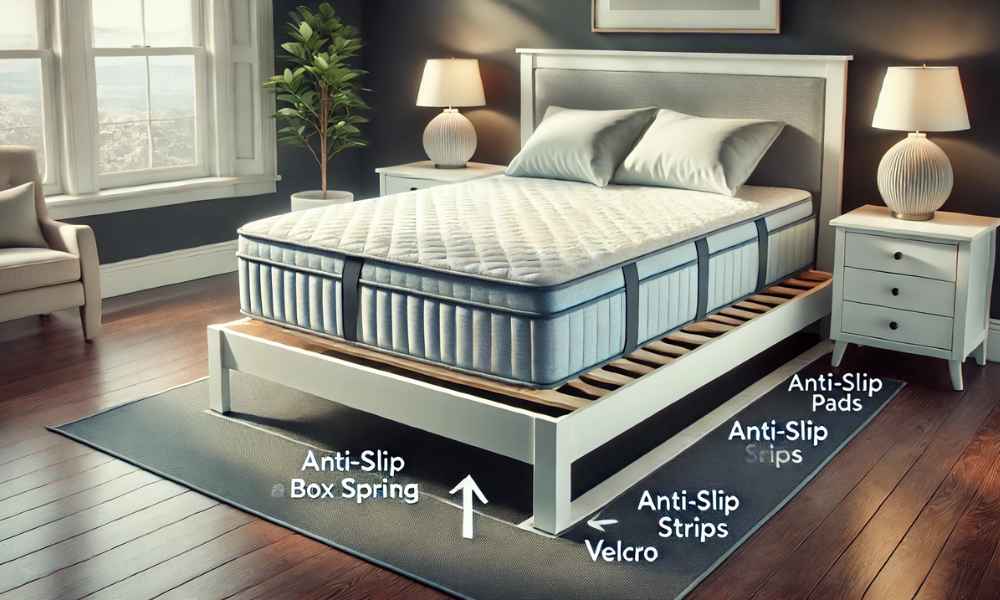A restful night’s sleep can quickly turn into a frustrating experience when your mattress refuses to stay put. A sliding mattress is not only inconvenient but can also impact sleep quality and contribute to discomfort. Whether your mattress constantly shifts every time you climb into bed or slides off the box spring gradually over time, finding a solution is essential for maintaining a stable, supportive sleeping environment. Fortunately, there are multiple ways to prevent this common issue. From quick DIY fixes to investing in the right type of bed frame, understanding why your mattresses slides and how to stop it will bring much-needed stability to your sleeping space.
Why Does Your Mattress Keep Sliding? Understanding the Causes
Before addressing the problem, it’s crucial to understand why a mattresses slides in the first place. Several factors contribute to this issue, and identifying the specific cause in your case will help you choose the most effective solution.
The Frustration of a Slipping Mattress – Why It’s More Than Just Annoying
Waking up to find your mattresses has shifted several inches off the box spring isn’t just a minor inconvenience—it can disrupt sleep, cause discomfort, and even pose safety concerns. A mattress that moves frequently can create an uneven sleeping surface, leading to misalignment of the spine and poor posture over time. Moreover, for those who toss and turn at night, an unstable mattress can contribute to restless sleep, preventing deep, restorative rest. If left unaddressed, a shifting mattresses can also damage surrounding furniture or even result in injury from unexpected slips.
Common Reasons Your Mattress Won’t Stay in Place
- Lack of Friction – Many mattresses, especially memory foam and latex models, have smooth undersides that don’t provide enough grip against the box spring.
- Worn-Out Materials – If the bottom of your mattress has become worn or the box spring has lost its texture, it may no longer provide adequate support.
- Bed Frame Issues – An improperly sized bed frame or a lack of side rails can allow the mattress to shift freely.
- Frequent Movement – If you’re an active sleeper or share your bed with a partner who moves a lot, constant motion can push the mattresses out of position.
- Flooring Type – If your bed is placed on hardwood, tile, or laminate flooring, the lack of friction can contribute to mattress movement.
Choosing the Right Mattress to Prevent Sliding
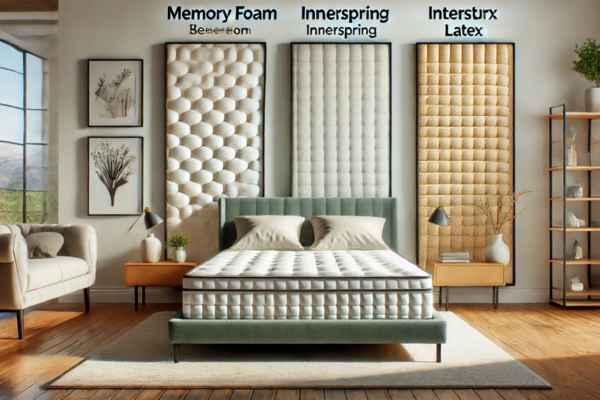
Not all mattresses are created equal when it comes to staying in place. If your mattresses is prone to sliding, it may be worth considering an upgrade or adding features that enhance stability.
- Memory Foam vs. Innerspring – Memory foam and latex mattresses are more prone to sliding due to their smooth surfaces, while traditional innerspring mattresses tend to have more grip.
- Textured Bottom Covers – Some modern mattresses come with anti-slip fabric on the bottom to reduce movement.
- Size Compatibility – A mattress that is too small for the bed frame will naturally move around more, so ensure a snug fit for better stability.
If purchasing a new mattress isn’t an option, other practical solutions can help secure your current one in place.
Quick and Easy DIY Fixes to Stop Mattress Sliding
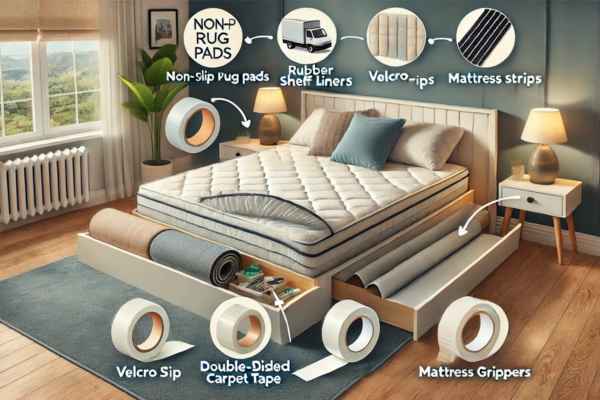
Before investing in costly replacements, consider simple do-it-yourself solutions to prevent mattresses movement:
- Non-Slip Rug Pads – Placing a grippy rug pad between the mattresses and box spring can create much-needed friction.
- Rubber Shelf Liners – These inexpensive liners can be cut to fit beneath the mattress, offering a quick and effective solution.
- Velcro Strips – Attaching adhesive-backed Velcro to both the mattresses and box spring can provide a secure hold.
- Carpet Tape – Double-sided carpet tape can be applied to the underside of the mattress for extra grip.
- Mattress Grippers – Special anti-slip pads designed specifically for mattresses can be purchased for added stability.
Upgrading Your Bed Frame for Maximum Mattress Stability
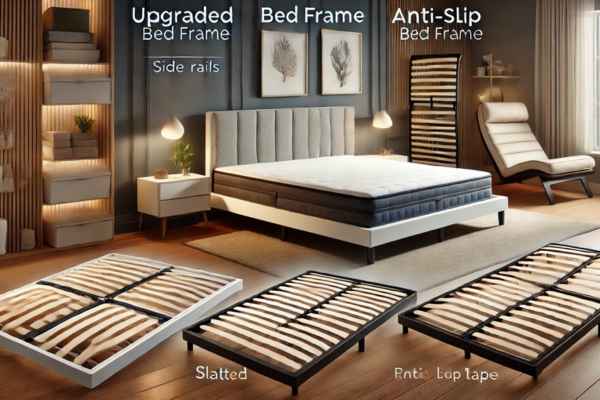
DIY methods don’t fully resolve the issue, upgrading your bed frame may be necessary. A well-constructed bed frame plays a crucial role in keeping a mattresses secure.
- Side Rails for Support – A bed frame with side rails can significantly reduce movement by providing a physical barrier.
- Slatted Bed Frames – Opting for a slatted base with anti-slip tape or a non-slip layer can add extra grip.
- Platform Beds – These solid bases provide maximum mattress stability and eliminate the need for a box spring.
- Adjustable Bed Frames – A high-quality adjustable bed frame with secure locking features can help prevent unwanted movement.
Using a Mattress Gripper Pad – A Game-Changer
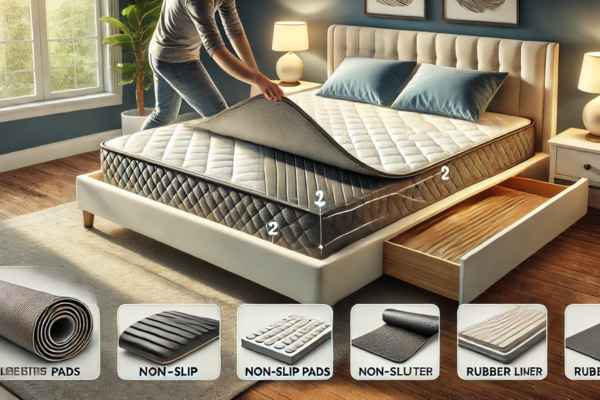
One of the simplest yet most effective ways to keep your mattress from sliding is to use a mattress gripper pad. These pads, made of non-slip rubber or textured materials, create friction between the mattresses and the box spring, preventing movement. Available in various sizes, they can be easily placed beneath the mattress without altering its comfort. For those seeking a cost-effective alternative, household items such as non-slip rug pads or rubber drawer liners can serve a similar purpose. These solutions provide extra grip, ensuring that the mattresses stays firmly in place, even for those who toss and turn throughout the night.
Anchoring Your Mattress with Straps and Clips
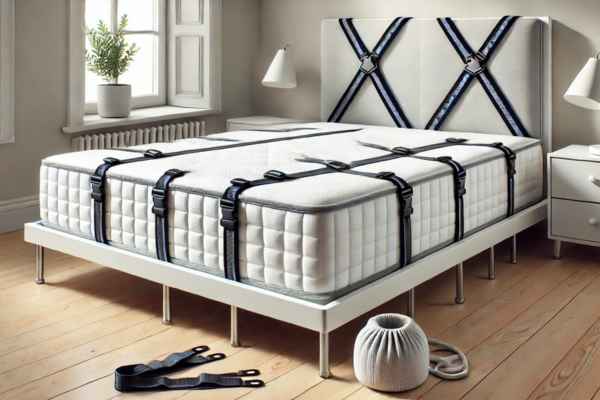
For an added layer of security, mattress anchoring straps and clips can be a highly effective solution. These straps attach the mattresses to the box spring or bed frame, creating a firm hold that eliminates sliding. Adjustable straps allow for a customized fit, ensuring stability without compromising comfort. Bungee cords can also be repurposed as an affordable DIY alternative. By securing them around the corners of the mattresses and attaching them to the bed frame, you can create a tight grip that prevents unwanted movement. Whether using commercial mattress straps or DIY options, anchoring your mattresses can provide a long-term solution to frequent shifting.
Preventing Slipping on a Platform Bed vs. Box Spring Setup
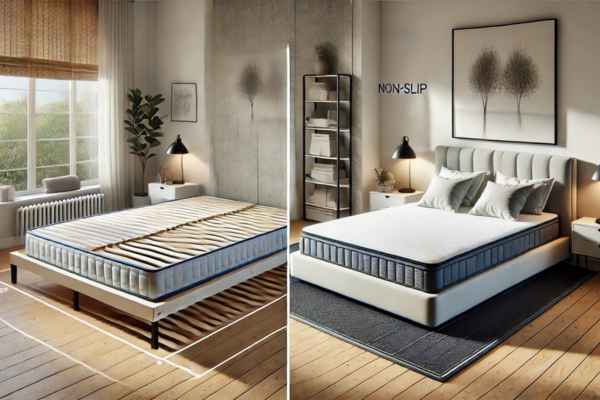
The type of bed frame plays a significant role in how well a mattress stays in place. While platform beds often provide a stable, non-slip surface, box springs tend to have smoother surfaces that can contribute to mattresses movement. To enhance stability in a box spring setup, consider placing a non-slip mat between the mattresses and the box spring. Additionally, upgrading to a bed frame with side rails can create a physical barrier that prevents sliding. If using a platform bed, ensure that the slats provide enough grip or add a grippy layer such as an anti-slip mattresses pad for extra security.
Adding a Non-Slip Mattress Cover for Extra Security
A non-slip mattress cover not only protects the mattresses from dust and spills but also adds another layer of friction to prevent movement. These covers are designed with grippy materials on the bottom side, helping to hold the mattresses securely in place. Look for mattress covers with textured surfaces or silicone grip features. These can be particularly useful for memory foam and latex mattresses, which tend to slide more due to their smooth exteriors. Choosing the right cover will enhance both mattress longevity and stability, ensuring uninterrupted sleep.
Checking Your Mattress and Box Spring for Wear and Tear
Sometimes, a shifting mattress is a symptom of an underlying issue. A worn-out mattresses or deteriorating box spring can contribute to instability, making it easier for the mattress to slide. Regularly inspecting both for signs of wear—such as sagging, weakened support, or a smooth, slick underside—can help identify whether it’s time for a replacement. If the box spring is the problem, consider adding a rubberized or textured layer to improve grip. If the mattress itself has lost its traction, flipping or rotating it can sometimes help. For long-term stability, investing in a high-quality mattresses and ensuring a well-maintained box spring will prevent future issues.
Alternatives to Box Springs: Is It Time for a Change?
Traditional box springs have been a staple in many bedrooms for years, but they aren’t always the best choice for keeping a mattresses in place. If you’re struggling with constant mattress movement, it may be time to consider alternatives.
Platform beds, for example, offer a more stable foundation with a solid or slatted surface that provides better grip. Memory foam and hybrid mattresses often perform better on platform beds compared to box springs. Adjustable bed bases also offer excellent stability while allowing for customizable sleeping positions. For those who still prefer a box spring, using an anti-slip pad or upgrading to a higher-quality box spring with better grip can be effective. Assessing whether your current foundation is the root cause of your mattresses movement can help determine if a switch is necessary.
How to Keep Your Bed Neat and Comfortable While Securing Your Mattress
A secure mattress doesn’t mean you have to sacrifice the look and feel of a well-made bed. In fact, keeping your bed tidy can actually contribute to mattresses stability. Tucking in bed sheets tightly around the mattresses can create extra friction, reducing its tendency to slide.
Weighted blankets or thicker comforters can also help apply downward pressure, keeping the mattress in place while adding an extra layer of coziness. Using fitted sheets with deep pockets that grip the mattresses tightly can further prevent movement. Additionally, ensuring that the bed frame itself is well-assembled and tightly secured can help eliminate unnecessary shifts caused by loose parts. Combining aesthetic appeal with practical solutions will help maintain both the stability and style of your sleeping space.
Why Does My Mattress Slide More on Hardwood Floors?
If your bed frame is placed on a hardwood, tile, or laminate floor, you might notice that your mattress shifts more frequently. The reason? A lack of friction. Unlike carpeted floors, which provide some resistance, hard flooring creates a smooth, slick surface that allows the bed frame—and consequently, the mattresses—to move with ease. To counteract this issue, placing non-slip rubber pads or grippers under the legs of the bed frame can help prevent unnecessary movement. Another solution is using a bed frame with side rails or a headboard and footboard, which naturally restrict mattresses movement.
Can I Use a Rug Under My Bed to Prevent Mattress Movement?
Yes, placing a rug underneath your bed can be an effective and stylish way to reduce mattress sliding. A thick, textured rug provides added grip for the bed frame, preventing it from shifting when you move. This can be particularly useful for hardwood or tile floors, where a slick surface contributes to mattresses movement. When choosing a rug, opt for one with a non-slip backing or place a rubberized rug pad underneath for additional stability. A large area rug that extends beyond the edges of the bed will not only enhance bedroom aesthetics but also provide a practical solution to keep the mattresses and bed frame firmly in place.
What’s the Best Long-Term Solution for a Mattress That Won’t Stay Put?
For those seeking a permanent fix, a combination of solutions is often the best approach. Investing in a non-slip mattress pad, securing the mattresses with Velcro strips or anchoring straps, and upgrading to a bed frame with better support can all work together to create lasting stability. Additionally, ensuring that the mattresses and box spring are in good condition is crucial. Over time, worn-out materials can contribute to increased movement, so regular inspections can help prevent future issues. Choosing the right mattress type, such as one with a textured bottom, can also minimize slipping over the long run.
Final Thoughts
A sliding mattress may seem like a minor annoyance, but it can significantly impact sleep quality and comfort. Whether it’s caused by the type of flooring, bed frame, or mattresses material, there are multiple ways to resolve this issue. By implementing the right solutions—such as using non-slip pads, upgrading to a more stable foundation, or even placing a rug under the bed—you can create a secure and restful sleep environment. Taking the time to address mattress movement now will lead to more comfortable and uninterrupted nights for years to come.
